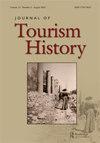Italia e Spagna nel turismo del secondo dopoguerra: società, politiche, istituzioni ed economia
IF 0.9
Q4 HOSPITALITY, LEISURE, SPORT & TOURISM
引用次数: 1
Abstract
and Safroni-Middleton were Englishmen, who were born and died in England, where they wrote their travel books. Both men spent time in Australia, but their non-Australian nationalities are evident from the useful biographical Appendix Halter provides, which reveals that, beneath their Australian disguise, many of Halter’s travelling white men and women were actually English, or Scots or Irish, or simply of ‘unknown background’. That is the real historical circumstance of Pacific travellers, of course, but it does somewhat undercut Halter’s pursuit of the authentically and distinctively Australian perspective on the South Seas. Halter is more a cultural-historian than a literary-historian, although he is perforce and dutifully both, and his chapters survey and document many depictions of the islanders and their white visitors. As he demonstrates, Australian religious, commercial and political concerns shaped the Australian national relationship with the islands. The Australian steamship and trading company Burns Philp opened many island shops. The Australian missions (Anglican, Presbyterian and even Catholic) added their (competing) strengths to the English, Scots and French evangelical forces. Meanwhile, the tourism competition took shape between the rival Edenic islands. ‘Tahiti is special’, according to an advertisement. ‘The Tahitians make sure it will always be so. They want their island to be truly Polynesian. They won’t worry if Tahiti gets less tourists than Hawaii. They will reserve Tahiti for the connoisseurs who will enjoy their wide sandy beaches ...with a special possessive pleasure. Discover Tahiti!’ Tahiti not Hawaii, that is. An accompanying photograph of a garlanded, grass-skirted, dancing island girl illustrates the ‘special possessive pleasure’ that awaits the tourists who will follow the eighteenth and nineteenthcentury travellers – and ‘discover’ Tahiti. The wide range of travellers and the variety of writings Halter has surveyed provide ample and credible evidence of the historical and cultural concerns of the Australian nation as it formed its own national identity while criss-crossing the South Sea islands. His Australian Travellers in the South Seas does succeed in demarcating a distinctively Australian relation to the Pacific Islands, although not all his travellers – some of them Anglo-Australian, some cosmopolitan men and women of the world – were actually Australian. They were international in their backgrounds as well as in their voyaging. His travel writers were also readers, of course, and they read internationally – the writings of American Melville and Scottish Stevenson, for example, who had already seen and imagined those factual and fictional islands.意大利和西班牙在二战后的旅游业:社会、政治、制度和经济
萨夫罗尼·米德尔顿是英国人,他们在英国出生和去世,在那里他们写了旅行书。两人都在澳大利亚度过了一段时间,但从哈尔特提供的有用的传记附录中可以明显看出,他们的非澳大利亚国籍,该附录显示,在他们的澳大利亚伪装下,哈尔特的许多旅行白人男女实际上是英国人、苏格兰人或爱尔兰人,或者只是“背景不明”。当然,这是太平洋旅行者的真实历史环境,但这确实在一定程度上削弱了哈尔特对真实而独特的澳大利亚南海视角的追求。哈尔特与其说是文学历史学家,不如说是一位文化历史学家,尽管他在这两方面都尽职尽责,他的章节调查并记录了许多对岛民及其白人游客的描述。正如他所展示的那样,澳大利亚的宗教、商业和政治关切塑造了澳大利亚与这些岛屿的国家关系。澳大利亚轮船和贸易公司Burns Philp在岛上开设了许多商店。澳大利亚使团(圣公会、长老会甚至天主教)为英国、苏格兰和法国的福音派力量增添了他们(相互竞争)的力量。与此同时,竞争对手埃德尼克群岛之间的旅游业竞争正在形成根据一则广告,塔希提岛很特别大溪地人确保它将永远是这样。他们希望他们的岛屿是真正的波利尼西亚。如果塔希提岛的游客比夏威夷少,他们不会担心。他们将为鉴赏家保留大溪地,他们将享受宽阔的沙滩。。。带着一种特殊的占有欲。发现塔希提岛!'塔希提岛,而不是夏威夷。随附的一张照片中,一个戴着花环、穿着草裙、跳舞的岛上女孩展示了等待游客的“特殊占有欲”,这些游客将跟随18世纪和19世纪的游客,“发现”塔希提。哈尔特调查的众多旅行者和各种各样的著作为这个澳大利亚国家在穿越南海诸岛时形成自己的民族认同提供了充分而可信的历史和文化关注的证据。他的《南海澳大利亚旅行家》确实成功地将澳大利亚与太平洋岛屿的独特关系划分开来,尽管并非所有的旅行家——其中一些是英澳混血儿,一些是世界上的世界主义男女——实际上都是澳大利亚人。他们的背景和航行都是国际化的。当然,他的旅行作家也是读者,他们在国际上阅读——例如,美国人梅尔维尔和苏格兰人史蒂文森的作品,他们已经看到并想象过那些真实和虚构的岛屿。
本文章由计算机程序翻译,如有差异,请以英文原文为准。
求助全文
约1分钟内获得全文
求助全文
来源期刊

Journal of Tourism History
HOSPITALITY, LEISURE, SPORT & TOURISM-
CiteScore
0.60
自引率
0.00%
发文量
16
期刊介绍:
The Journal of Tourism History is the primary venue for peer-reviewed scholarship covering all aspects of the evolution of tourism from earliest times to the postwar world. Articles address all regions of the globe and often adopt interdisciplinary approaches for exploring the past. The Journal of Tourism History is particularly (though not exclusively) interested in promoting the study of areas and subjects underrepresented in current scholarship, work for example examining the history of tourism in Asia and Africa, as well as developments that took place before the nineteenth century. In addition to peer-reviewed articles, Journal of Tourism History also features short articles about particularly useful archival collections, book reviews, review essays, and round table discussions that explore developing areas of tourism scholarship. The Editorial Board hopes that these additions will prompt further exploration of issues such as the vectors along which tourism spread, the evolution of specific types of ‘niche’ tourism, and the intersections of tourism history with the environment, medicine, politics, and more.
 求助内容:
求助内容: 应助结果提醒方式:
应助结果提醒方式:


